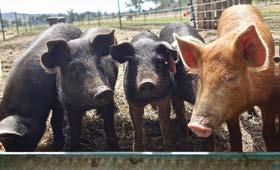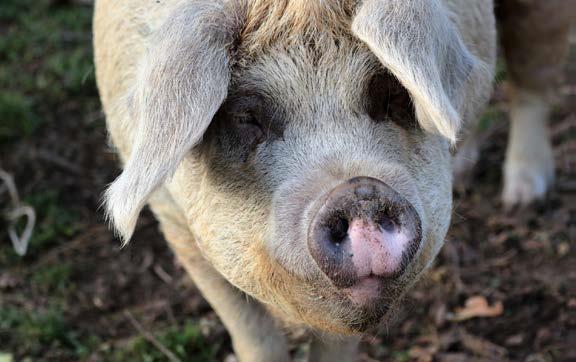The success of a piggery lies in the quality of the breeding programme and breeding practices.
Using superior genetics and efficient culling will ensure that your pigs are genetically sound, but also limit the costs of pigs that are not producing optimally.
In the case of a small-scale farm with 20 or fewer breeding sows, the following selection and breeding programme can be used:
- Always buy good (above average) purebred boars.
- Buy boars from prominent breeds used in your country.
- When buying gilts (young female pigs) for the first time, make sure that they come from a breeder with good pigs and who keeps accurate records.
- When at a later stage you want to select your own gilts for breeding, it is important to apply strict selection measures and to keep accurate records of growth and feed conversion.
- Always buy gilts from the same breeder (farm) and make sure that a breeding plan (policy) is used.

Small-scale piggery.
The correct selection, management and use of boars will have a significant impact on the profitability of your piggery, even if you have a small-scale pig farm.
Boar selection, management and use
- Select boars that are free from defects
- Buy efficient animals that:
– grow faster than average
– have less backfat than the average of the breed
– have eaten less feed than average to reach a specific weight.
Breeding pigs
Buy boars at least four or five weeks before they are used for the first time. This will allow you time to keep them in quarantine and the boars to adapt to the new environment. Young boars must be carefully supervised to identify possible problems and to make sure that they will not injure themselves when serving a sow for the first time.
Important considerations:
- The boar must be at least 8 months old.
- The boar and the sow should preferably be about the same size.
- The boar should work (serve the sow) in his own pen or in a pen that is familiar to him.
- The floor of the pen must not be slippery and all obstructions removed.
- A small sow and not a gilt should be used to train the boar.
Procedures when using a boar
The boar should be in the pen a few minutes before the sow is brought into it so that he can get used to the pen. Stand in the pen with a board ready to prevent the sow from harassing the boar or the boar from harassing the sow, if necessary. Do not hurry the boar, let him work at his own time.
Talk gently to the boar so that he gets used to your presence. Do not force the boar to mount the sow but direct him gently to the rear (backside) of the sow. If the sow is well on heat, she will not move around the pen too much. Help the boar by letting the sow stand with her head to the corner of the pen.
By adjusting the female’s tail, attempt to let the boar insert himself. After service, allow the boar to conduct “courtship” under supervision for a few minutes, but do not allow him to remount. If a young boar does not serve the first time, repeat the above procedures every two to three days if possible. Much patience is needed which will eventually be rewarded by having boars which are temperamentally good with sows and people and which have no bad habits.
Once a young boar starts to work, he should not be used more than twice a week until he is one year old. Older and full-grown boars (mature) can be used three times a week, but preferably not on consecutive days. On a farm with 20 breeding sows, at least two boars must be kept, namely a young boar to serve gilts that come onto heat for the first time, and a fullgrown one to serve older and heavier sows. It is also advisable to have a spare boar available at all times.
Finally, it is important to keep records. The dates when the boar served a sow as well as the number of the sows that have been served must be recorded so that infertile boars and boars that give small litters can be identified and eliminated.
We thank the South African Department of Agriculture for the information provided to the readers of Botswana, Namibia and Zimbabwe in this article series. For more information visit their website at https://www.daff.gov.za/.









